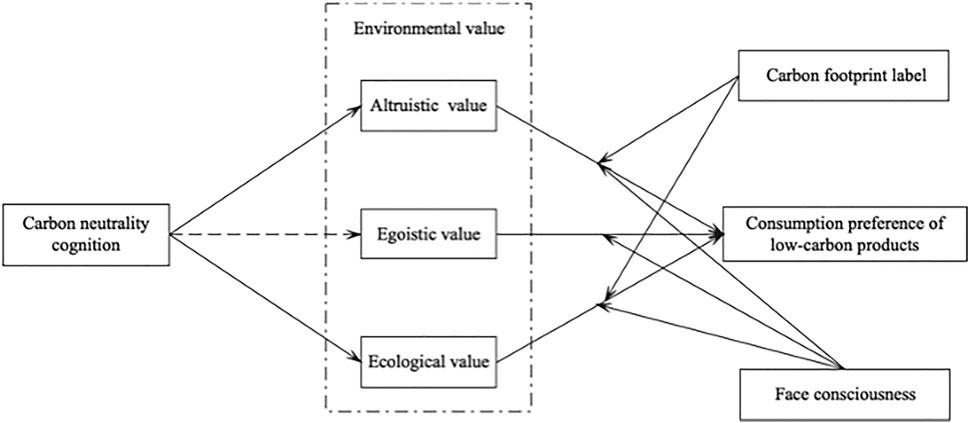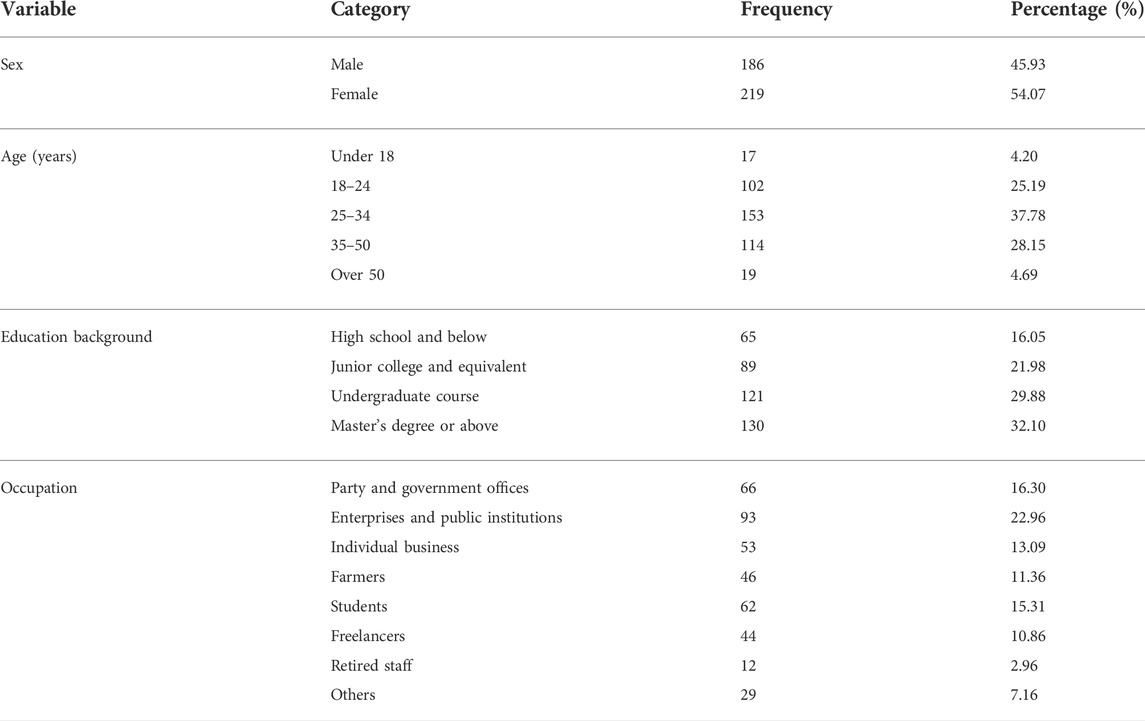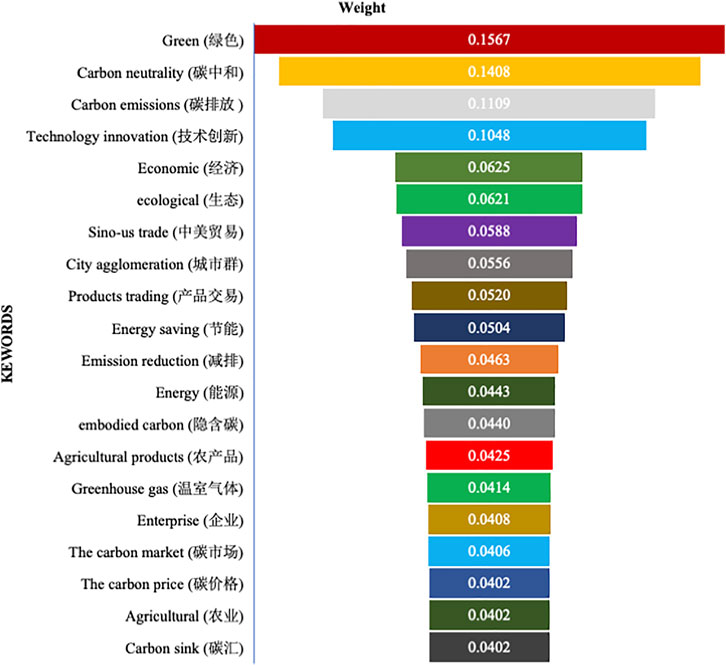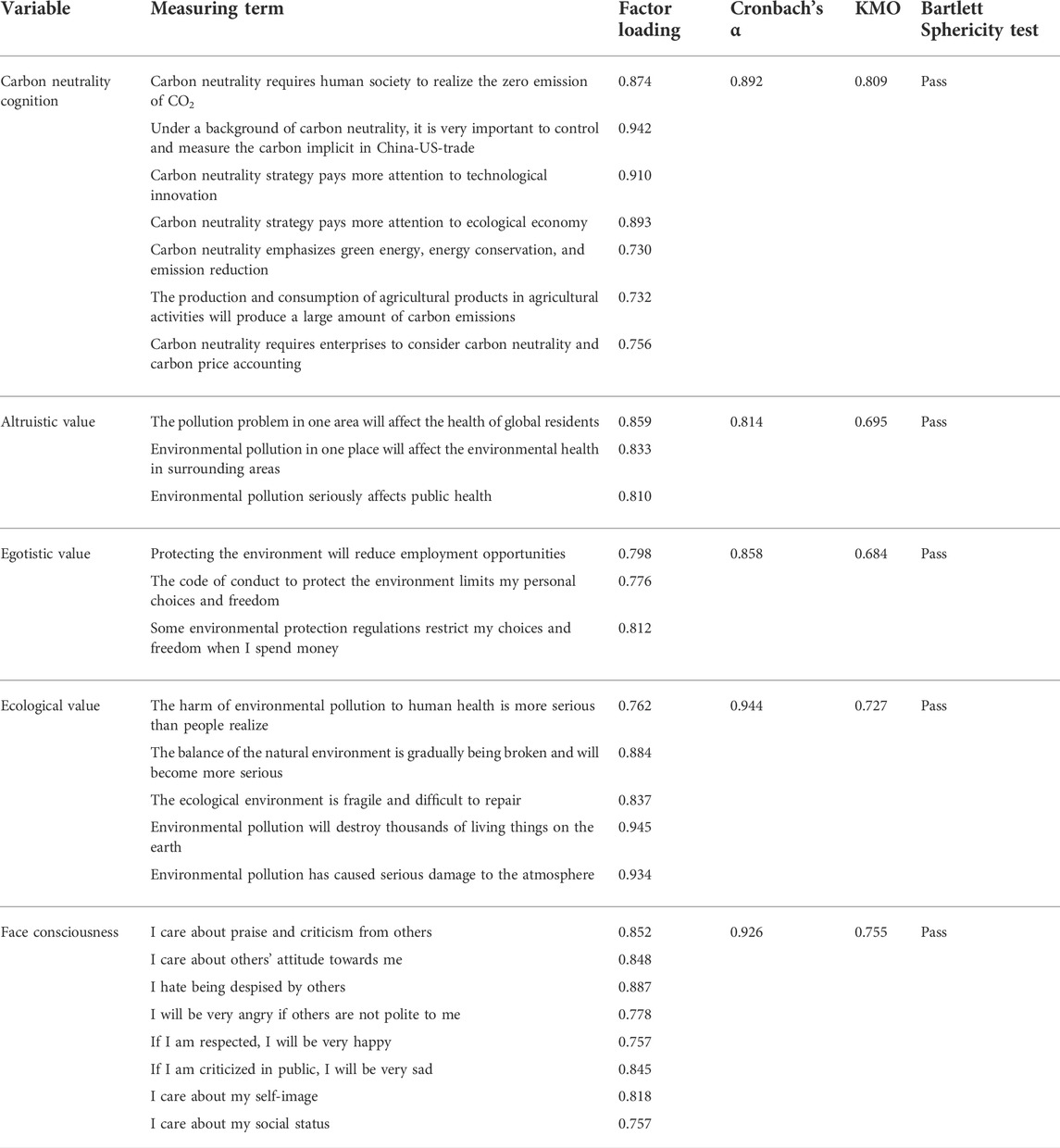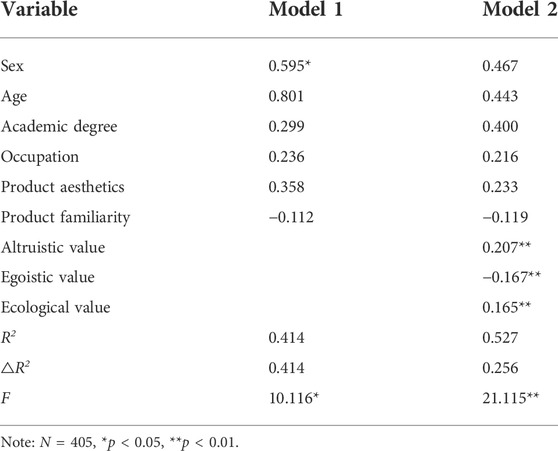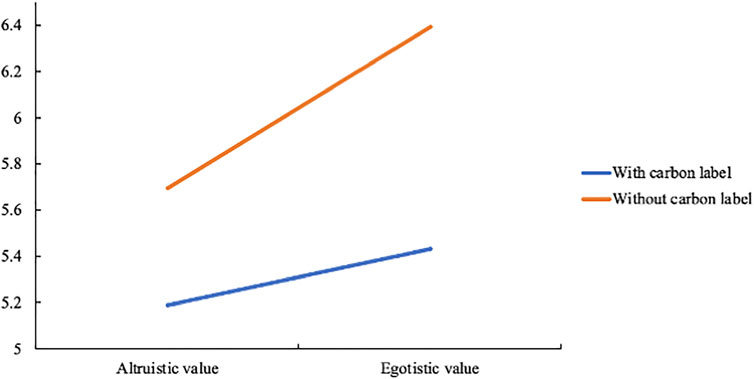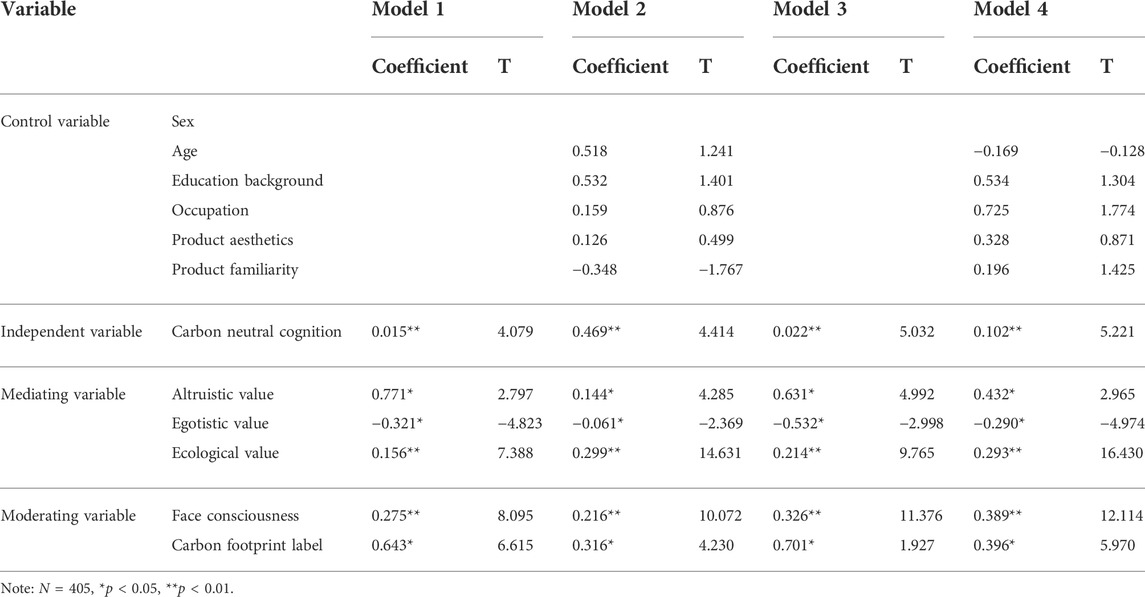- School of Marketing Management, Liaoning Technical University, Huludao, China
It is now the mainstream scientific consensus that carbon emissions cause global climate change. Achieving the goal of China’s carbon neutrality is essential for environmental protection and economic sustainable development worldwide. In the above context, this paper aims to explore the carbon neutrality cognition, environmental value, and consumption preference for low-carbon products from the perspective of consumption end. Thus, we built and checked a new conceptual model of consumers’ carbon neutrality cognition and the consumption preference for low-carbon products. The TF-IDF algorithm in machine learning was used to confirm the dimensions of carbon neutrality cognition based on text data collected from an academic database CNKI. Then, we used data from a social investigation (N = 405) to test hypotheses and models using bootstrapping and independent sample t-tests. The results showed that altruistic (β = 0.168, 95% CI: [−0.54514, 0.8819]) and egoistic values (β = −0.066, 95% confidence interval [CI]: [−0.6361, 0.6772]) mediated the impact of carbon neutrality cognition on the consumption of low-carbon products, whereas the egoistic value did not (β = −0.066, 95% CI: [−0.6361, 0.6772]). Additionally, based on the characteristics of current Chinese consumers and the market, we argue for two boundary factors: face consciousness and carbon footprint label. The moderation of face consciousness (Mhigh = 5.395 vs. Mlow = 3.312) and carbon footprint label (Mwith = 6.394 vs. Mwithout = 5.432) were revealed. The empirical results support our conceptual model, and our findings provide insights to policymakers and enterprises regarding people’s carbon neutrality cognition, which will allow them to develop more appropriate policies and sustainable development strategies.
Introduction
The goal of carbon neutrality is a momentous strategic decision taken by the Chinese government to promote the “green recovery” of the economy after the COVID-19 outbreak, by considering the development concept of “Green water and hills are golden and silver hills,” the background of the green transformation and development of the domestic economy and society, and by fully weighing the advantages and disadvantages of the international community in reducing carbon emissions (Wang, 2021). Low-carbon consumption is confronted by vital challenges and opportunities, under the conditions of a “dual circulation” development pattern in which the domestic economic cycle plays a leading role whereas the international economic cycle remains its extension and supplement. In the current context of international and Chinese economic development, carbon reduction is essential for global sustainability.
Specifically, it is not reasonable to focus on large production-based carbon emissions instead of consumption-based carbon emissions. Production-based carbon emissions refer to the amount of CO2 emitted during the production of products; consumption-based carbon emissions are the amount of CO2 emitted during the consumption of products. Although these emissions have different sizes, both are essential for carbon reduction. Moreover, carbon emissions from consumption can drive carbon emissions from production. Reducing carbon emissions from consumption can effectively force enterprises to develop technological innovations that reduce carbon emissions from production (Wang, 2015). As a consequence, a low-carbon lifestyle and consumer behavior are indispensable for achieving the goal of carbon neutrality. Thus, consumers’ cognition of carbon neutrality, responsibilities, and environmental value are particularly important in the process of daily consumption (Zhuang, 2021).
Research on low-carbon consumption focuses on green consumption, ecological consumption, and prosocial behaviors. However, studies of low-carbon consumption focus on the antecedent that affects the consumers’ psychology and behavior related to the consumption of low-carbon products. Prior research reported that environmental literacy includes four aspects: value, responsibility, problem perception, and behavioral skills. Homoplastically, a conceptual model of green consumption behavior with green consumption willingness as the intermediary mechanism was established (Kheiry and Nakhaei, 2012). Six dimensions of environmental emotion have been verified: environmental anxiety, behavioral disgust, behavioral guilt, environmental love, behavioral appreciation, and behavioral pride, based on the two-factor theory hypothesis of affection-behavior (Wang, 2015). Then, the influence mechanism of environmental emotion on consumers’ carbon reduction behavior was examined. From the perspective of environmental value, previous studies demonstrated the significant influence of altruistic value and egoistic value on young consumers’ willingness to consume organic green food (Yadav, 2016). Analogously, the existing body of research on generation X consumers’ ecological purchase behavior suggests that higher consumption preference and willingness to pay a premium are increased by personal, social, and cultural values (Lee and Park, 2018).
Because some Chinese consumers prefer saving face, the face awareness of Chinese consumers has had a positive impact on the purchase intention of green products. Furthermore, the mediation of perceived social value and moderation of use situation, and relative price level were examined (Yu et al., 2019). Specifically, Chinese consumers prefer environmentally friendly products with higher prices if the product is used in a public situation. Currently in China, there are no official laws, regulations, or policies related to carbon footprint labels. Therefore, academic research on carbon footprint labels has mainly focused on the calculation of carbon emissions in carbon footprint labels, the evaluation of accurate measurement methods, and promotion strategies for carbon footprint labels (Wang et al., 2010).
Given the current strategic goal of carbon neutrality, recent Chinese research has investigated the concept of carbon neutrality. These studies analyzed the relationship between carbon neutrality strategies and high-quality development of the domestic economy from a macro perspective to submit proposals to the government and other enterprises. Our literature search found few studies have measured consumers’ carbon neutrality cognition from the perspective of micro consumer psychology. Therefore, our research problems were 1) what is the consumers’ carbon neutrality cognition? 2) What is the specific relationship between carbon neutrality cognition and consumption preference for low-carbon products? And 3) Are there mediations and boundary conditions between the two? This paper introduces a scheme that solves these problems through social investigation and experimental design. First, consumers’ carbon neutrality cognition was identified by social investigation using a questionnaire survey and TF-IDF algorithm in machine learning. Second, the main effect of carbon neutrality cognition on the consumption preference for low-carbon products was explored using linear regression. Third, we considered and checked two boundary conditions of the conceptual framework: face consciousness and carbon footprint label to reveal their moderation roles under a background of Chinese collectivist culture. Finally, we conducted a robustness check of our conceptual model to guarantee the generalizability of the conclusions.
This paper contributes to research on carbon neutrality cognition and carbon footprint label, which has not been considered important and which lacks a national standard in China. In addition, our results indicate that a carbon footprint label can positively promote consumers’ consumption preference for low-carbon products, which provides evidence demonstrating the necessity and importance for the government to establish a carbon label institution. Our insights into consumers’ carbon neutrality cognition suggest low-carbon consumption can be increased, and that a Chinese carbon neutrality strategy can be achieved as soon as possible from the perspective of the carbon reduction of consumption.
Literature review and hypothesis
Environmental value and consumption preference for low-carbon products
Value is the standard to measure cognition gradually formed by individuals in the process of learning and accumulating experience (Kahle, 1996). Individuals regulate and adjust behaviors through value, and there are differences in value among individuals (Fraj and Martinez, 2006). Simultaneously, value is the standard and viewpoint of individuals to understand and deal with problems. Thus, value is an important factor for individual cognition including the basic viewpoints of the subject towards the object (Arrow, 1951). Undoubtedly, environmental value is also one of the categories of value. According to the classical theory of value-belief-norm, the environmental value is divided into altruistic, egoistic, and ecological values (Stern, 2000). The altruistic value focuses on being considerate of others, whereas in contrast, egoistic value emphasizes thinking for yourself (Hansla et al., 2008). The ecological value promotes the idea that humans belong to the natural environment, and that people should respect and protect nature (Wang and Zhou, 2019). The concept of altruistic behavior has been applied to the research of recycling behavior (Hopper and Nielsen, 1991), energy-saving (Black et al., 1985), and environmental protection political action (Stern and Paul, 1976).
Based on the concept of altruistic behavior, an altruistic value was proposed (Schwartz, 1992). Prior research reported that altruistic value had a remarkable impact on consumers’ environmental attitudes, subjective norms, perceived value, and environmental behaviors (The et al., 2017). In addition, the literature indicated that green consumption was increased by altruistic values, because these values are a key factor that guide an individual’s moral behavior and significantly affect consumers’ attitudes. Driven by altruistic values, consumers prefer environmental-friendly and recyclable products, whereas non-environmental-friendly and non-recyclable products negatively impact consumers’ environmental attitudes (Ali et al., 2020). In summary, consumers prefer to make consumption decisions from the perspective of environmental protection rather than only considering ordinary functions of products (Yadav, 2016).
Egoistic value is the judgment standard of positive benefits that are often related to specific behaviors based on the perceived benefits. Previous studies indicated that the correlation between consumers’ perceived benefits and purchase intention could be explained by the theory of planned behavior (Ajzen, 1991). Consumers pay more attention to the cost price, discount, and performance of products in the purchase decision process, with less consideration given to the production factors of altruism (Forsythe et al., 2010).
Ecological value emphasizes people’s responsibility for the natural environment. The deterioration of the ecological environment requires society to improve the positive awareness of environmental protection; thus, the concepts of ecological consumption and ecological value have been proposed. Ecological value will significantly promote consumers’ environmental protection behavior and ecological consumption behavior (Wang and Zhou, 2019). Greater environmental concern and stronger ecological value orientation can promote individuals’ pro-environmental behavior and low-carbon behavior, such as turning off the TV standby mode, purchasing less packaged products, using public transportation frequently, and taking short trips by bicycle (Chng and Borzino, 2020). Accordingly, our first two hypotheses are as follows:
H1. : Consumers’ consumption preference for low-carbon products is significantly influenced by environmental values, specifically, altruistic values and ecological values that positively influence the consumers’ consumption preference for low-carbon products (H1a), whereas egoistic values negatively influence the consumers’ consumption preference for low-carbon products (H1b).
Carbon neutrality cognition and environmental value
The concept of carbon neutrality was first proposed by the British company Future Forest.1 The company advocates residents to purchase carbon credits to neutralize and offset carbon emissions based on the concept of ecological environment protection. At present, carbon neutrality has become one of the most important issues for the international community. Carbon neutrality requires carbon generated by human society during economic development to be offset by forest carbon sinks, energy conservation, emission reduction, and other forms of artificial technology for capture and storage, to achieve zero-emission CO2 (Kahle, 1996). For instance, commercial building operations with high emission abatement potential are important steps to achieve global carbon neutrality (Xiang et al., 2022; Zhang et al., 2022). Reducing carbon emissions in the building sector is essential for carbon peak and carbon neutrality (Sun et al., 2022), and mission factors and industrial structures are key to decarbonizing building operations (Xiang et al., 2022).
China has made it clear that it will strive to peak its CO2 emissions by 2030 and achieve the goal of carbon neutrality by 2060 (Xi, 2020). From the perspective of macro-economic development, under the guidance of the carbon neutrality target, the social responsibility of production enterprises should be implemented from the supply side and the responsibility of consumers should be highlighted to force the transformation and upgrading of energy and industrial structures. From the point of view of microscopic consumption psychology and cognition, the consumers’ recognition of carbon neutrality and low-carbon consumption concept will become a new consumption value to form market demand, which will further promote technological innovation, energy conservation, and the carbon reduction of enterprises, which will eliminate enterprises with high energy consumption and high carbon emissions. As a consequence, the importance of consumers’ carbon emission reduction and consumers’ cognition of carbon neutrality cannot be ignored, when determining the peak CO2 emissions, and carbon neutrality target schedule and map (Zhuang, 2021).
Prior research suggested that attitude, perception, and belief can guide behavior and preference (Kaplan, 2016). Thus, the consumers’ cognition of carbon neutrality has also an impact on the consumption behavior of low-carbon products. Additionally, altruistic and ecological values were closely related to prosocial behavior, environmental protection, and carbon reduction (Chekima et al., 2016). Low-carbon consumption behavior advocates prosocial, low-carbon emission, and green consumption behavior to eliminate consumption pollution and carbon emissions caused by irrational consumption (Yu and Gong, 2015). Other studies demonstrated that people’s environmental values will affect ecological consumption behavior through subjective norms, environmental attitudes, and perceived behavior control (Wang and Zhou, 2019). Moreover, altruistic and ecological values will positively affect the consumption behavior of low-carbon products through perceived behavior effectiveness, whereas in contrast, egoistic values have a negative effect on the consumption behavior of low-carbon products (Roos and Hahn, 2018). Therefore, a second hypothesis was proposed as follows:
H2. : Altruistic and egoistic values mediate the impact of carbon neutrality cognition on the consumption of low-carbon products, whereas egoistic values do not.
The mediations of face consciousness and carbon footprint label
Face consciousness based on Chinese society and impression management theory describes the attitude and cognition of others to oneself, which is characterized by social attributes and openness (Yu et al., 2019). Face consciousness mainly includes the expectation of maintaining face, improving face, and avoiding losing face during social activities (Bao et al., 2019). Driven by face consciousness, consumers’ psychology and behavior tend to be diversified. If consumers are very concerned about the attitudes and opinions of the people around them, they will have a strong sense of face consciousness and will maintain face by paying attention to the symbolic attributes and social status attributes of products. For instance, luxury consumption is typical face-saving behavior. Luxury products are a symbol of hedonism (Yu et al., 2019) because luxury products can indicate the consumer’s great wealth and high social status. The consumption of low-carbon products demonstrates environmental protection and prosocial behavior, and consumers can build a personal reputation by participating in prosocial behavior (Semmann et al., 2005). Compared with general consumption behavior, the consumption of low-carbon products is more related to the social and public interest, which can win the respect and approval of others to increase one’s own face (Goh et al., 2021).
Specifically, for consumers with strong face consciousness, prosocial behavior benefits others and themselves. Not all people have a strong face consciousness. When people’s ecological value is high, it is still possible to seek a lifestyle that demonstrates social status or identity, and a lifestyle with higher social status is often accompanied by higher energy consumption compared with an ordinary lifestyle. For instance, the consumption of oil resources by the large displacement engines of luxury cars generates a high amount of carbon emissions. From the perspective of egoism, the use of low-carbon products or energy-saving green products will not themselves bring a higher quantity lifestyle, because they are inconsistent with the sufficiency enjoyment motivation advocated by the status-seeking lifestyle (Griskevicius et al., 2010). Therefore, face consciousness and ecological value can have a negative impact on environmental willingness and energy-saving behavior as well as weakening energy-saving and environmental protection behaviors (Wang et al., 2019). Accordingly, a third hypothesis was proposed as follows:
H3. : Face consciousness moderates the impact of environmental values on the consumption of low-carbon products. Under the condition of high face consciousness, the effects of altruistic, egoistic, and ecological values on the consumption preference for low-carbon products is positively moderated by face consciousness (H3a); under the condition of low face consciousness, the effects of ecological values on the consumption preference for low-carbon products is negatively moderated by face consciousness (H3b). Paradoxically, the moderating effect of face consciousness on altruistic values, egoistic values, and consumption preference for low-carbon products disappears (H3c).A carbon footprint label attached to packaging provides information related to the product. The CO2 emission generated during the whole life cycle of the product from production to consumption is marked on the label to inform consumers of the carbon footprint of the product to be purchased (Wang et al., 2010). Previous studies reported the use of carbon footprint labels for products and services increased consumers’ attention to carbon emissions (Owususekyere and Jordaan, 2017), and significantly affected consumers’ purchase decision behavior (Emberger-Klein and Menrad, 2017), even increasing the willingness to pay a premium for the consumption of low-carbon products (Msl et al., 2019). Simultaneously, the importance of carbon footprint labels on agricultural and pastoral meat products for food consumption carbon reduction was determined by measuring the functional relationship between the forest reduction area and carbon emissions. Producing meat products is related to the cutting down of green vegetation; thus, consumers will consider whether the meat products meet a criterion of low-carbon consumption, which will arouse more attention from consumers to the carbon footprint of the products (Cederberg et al., 2011).As a consequence, whether the products have a carbon footprint label will affect consumers’ consumption behavior of low-carbon products. The carbon footprint label has developed from a public welfare label to information necessary for some developed countries. The carbon footprint label is the embodiment of ecological values in consumption and products. Values related to environmental protection and ecological friendly cultural beliefs can affect consumers’ purchase behavior. Therefore, we propose a fourth hypothesis as follows:
H4. : Whether a product has a carbon footprint label moderates the effect of altruistic and ecological value on the consumption preference of low-carbon products. Altruistic and ecological values have a stronger impact on the consumption preference of low-carbon products with a carbon footprint label than without a carbon footprint label (Figure 1).In summary, current research has predicted technologies and perspectives to achieve carbon neutrality (Wang et al., 2021), and has demonstrated that emission forecasting is vital for policy-making and emission reduction goals globally (Ikram et al., 2021). From the perspectives of macro energy type (Ikram, 2021) and green development (Ikram et al., 2022), carbon reduction and carbon neutrality play important roles in sustainability. Our research focuses more on the micro points of consumers and psychology and contributes to helping governments and enterprises understand people’s carbon neutrality cognition, environmental values, and preference for low-carbon consumption.
Methods and materials
Questionnaire design
The questionnaire design included three parts. The first part was the design of the situation of the consumers’ consumption preference for low-carbon products. The second part was the measurement design of the variables, including the measurement of six core variables: carbon neutrality cognition, altruistic value, egoistic value, ecological value, face consciousness, and consumption preference for low-carbon products. The last part was the collection of basic demographic information, including sex, age, occupation, and education level.
First, we determined the type of product that was most relevant to carbon neutrality, carbon reduction, and low carbon to achieve a reduction in carbon emissions by daily consumption to design the purchase intention. Prior studies suggested that the greenhouse gas emissions generated by agriculture and animal husbandry accounted for 18% of the global carbon emissions (Pardo et al., 2016), and the carbon emissions generated by breeding were huge because of the large amount of carbon emission equivalents generated by ruminant intestinal fermentation. For example, in South Africa in 2019, agricultural and livestock produced 35.37 million tons of CO2 (Tongwane and Moeletsi, 2021), and the carbon emissions from the intestinal fermentation of agricultural and livestock accounted for 64.54%. Moreover, the carbon emissions from commercial beef used for market circulation accounted for 50.21%.
With the rapid development of internet communication technology, smartphones have become indispensable communication and entertainment tools in people’s daily life with a high penetration rate. According to Apple’s official product environment report,2 one iPhone 12 produces 82 kg of CO2 during the source material production manufacturing, packaging, use, and recycling. During the product life cycle, carbon emissions from logistic transportation, service, and end-of-life treatment processes account for 2%, 11%, and 1%, respectively. In addition, carbon emissions generated by the production and manufacturing were the largest: 86% (70.52 kg). The carbon emissions of electronic products such as mobile phones cannot be ignored, and these are mainly concentrated in the production and manufacturing processes. One of the industries with the greatest energy saving and emission reduction potential in China is the clothing and textile manufacturing industry, which is expected to reduce the domestic industrial sector’s carbon emissions by 28.65% (Li and Xu, 2020). According to estimates by the British Environmental Resources Management Company,3 a pair of jeans weighing 400 g will produce about 47 kg of carbon emissions over the product life cycle, which is 117.5 times the weight of the product itself. China is a country with a huge population and a large domestic clothing and textile market; therefore, the carbon emissions from the supply and consumption of clothing are high.
Based on the evidence analysis described above, this study used commercial beef, smartphone, and clothing as alternative products in the questionnaire situation design and our preliminary research let participants select the most appropriate stimulus materials. In the preliminary study, participants were asked to look at three pictures showing beef, smartphones, or clothing, with a description of low-carbon products and the carbon emissions generated by each kind of product. Finally, we asked participants the question: “Which type of products in the pictures do you think have more properties and characteristics of low-carbon products?” using the Likert 7-point scale. A total of 148 valid questionnaires were collected, and 47.3% of participants were male. Results demonstrated that the participants were more inclined to choose the mobile phone, which is more appropriate for the properties and characteristics of low-carbon products (Mmobile phone = 5.232 > Mbeef = 4.634 > Mjeans = 4.026, SD = 1.48).
In the formal questionnaire, a virtual brand of mobile phone (A brand) was used as an experimental stimuli. The materials in the questionnaire are shown in Figure 2, which showed the internal information of the mobile phone system (left of Figure 2) and the external package information (top right of Figure 2) to the participants. The purchase situation was described as: “Beef, clothes, and electronic products we use in daily life. These products will produce certain CO2 emissions from their production, manufacturing, packaging, and use, which is a challenge for our country to achieve the goal of carbon neutrality strategy in the future. We have the following A brand mobile phone with a low-carbon design concept. Please carefully observe the picture and finish answering.” Considering that the popularity and knowledge of carbon footprint labels are low, an explanatory text about carbon footprint labels was added: “Carbon footprint labels are the quantitative index marks of CO2 emissions generated from the production processes of goods on the product labels.”
Data collection
The formal questionnaire for field research was distributed and collected online, and was anonymous. The specific steps of data collection were as follows: 1) Develop an online questionnaire using Credamo, an online platform, to investigate and generate answer QR codes and links; and 2) Distribute online questionnaires and paper questionnaires randomly and pay ¥ 5 to each participant. Finally, 426 questionnaires were collected, and 405 valid questionnaires were retained. The structural characteristics of the samples are shown in Table 1.
Variable measurements
We explored the dimensions of carbon neutrality cognition accurately from the perspective of academic research. Because 1) the background of this study was based on the strategy of China’s current economic situation and need for carbon neutrality, 2) the participants in our social investigation were mainly from China, and 3) we needed consistent participants and questionnaire test items, we chose the China National Knowledge Infrastructure (CNKI) as the text database because of its obvious characteristics of local research in China. We collected 181 Chinese Social Sciences Citation Index (CSSCI) papers from 2011 to 2021 with advanced search keywords including “carbon neutrality,” “peak CO2 emissions,” and “zero carbon emission” in the database as source data.
Then, we manually reviewed the titles and abstracts of the papers and eliminated 22 papers that were not associated with carbon neutrality. Finally, 159 papers were retained as source text data. Next, a Word 2 Vector model (Muhammad et al., 2021) was established using the SVM of machine learning and NLP. Homoplastically, TF-IDF was used for keyword calculation and a word frequency statistical algorithm was used to confirm high-frequency words. The collection, cleaning, and processing flow of the paper text data are shown in Figure 3. The visualization of the results of word frequency statistics is shown in Figure 4, where the first 1000 most frequent words are arranged from high to low frequency. The larger the word size in Figure 4, the more times the word appears in the paper text data.
Note: 1) Because our text data set were in Chinese, the results are displayed in Chinese in Figure 4 after running the Python program. 2) Keyword results of original text data are shown inside parentheses in Figure 5, and words outside the parentheses are a Chinese-English translation.
To ensure the accuracy of the high-frequency words, TF-IDF was run in a Python environment to extract the keywords in the paper text data. The basic mathematical derivation of the TF-IDF algorithm was:
In Formula 2,
Based on drawing lessons from previous research on scales of low-carbon awareness (Liu and Ji, 2019), low-carbon cognition (Tang et al., 2018), and environmental sentiment (Wang, 2015), as well as the current study’s machine learning quantification of carbon neutrality cognition, nine items for measuring carbon neutrality cognition were adapted and formed. Previous scales were used to measure altruistic values (3 items), egoistic values (3 items), ecological values (5 items) (Wang and Zhou, 2019), and face consciousness (8 items) (Chan et al., 2009). Exploratory factor analysis was conducted on the nine observed variables of carbon neutrality cognition. The results showed that the factor loadings of two observed variables: “Carbon neutrality strategy requires an enhanced forest carbon sink” and “metropolitan area and urban agglomeration play an important role in carbon reduction and emission” were 0.453 and 0.397, respectively, both of which were lower than 0.5. Therefore, these two observed variables were eliminated and seven observed items of latent variables were retained. The above measurement items are shown in detail in Table 2.
Data and results
Tests of reliability and validity
First, the internal consistency method using Cronbach’s α was used to test the reliability of the measurement scale. Table 2 shows that each Cronbach’s α was in the range of 0.814–0.944. Thus, the internal consistency of each variable was highly reliable, higher than the acceptable value of 0.7 s, and the KMO of the whole scale was 0.822, p < 0.001, which indicated that it was a suitable for factor analysis. Six factors with an eigenvalue greater than 1 were extracted, and the accumulated variance contribution rate was 85.28%. The factor loadings were all higher than 0.7; therefore, the research scale had high validity.
Common method deviation test
This paper tested whether the data had common method deviation using program control and statistical control (Podsakoff et al., 2003). The operation of the applied program control was as follows: 1) Disrupting the order of the questionnaire items to prevent the participants from guessing the intention of the items. 2) We promised that the data collected from anonymous questionnaires would only be used for academic research and that we would not collect personal privacy data to ease the concerns of the participants. In addition, the statistical control mainly used correlation analysis. The correlation coefficients of the core variables involved in this paper were all in the range of 0.110–0.575, which are lower than the critical value of 0.9. Therefore, the common method deviation of data was not obvious (Table 3).
Hypothesis test
Multiple regression analysis was conducted for altruistic, egoistic, and ecological values, and the consumption preference of low-carbon products, and sex, age, education background, occupation, aesthetic design, and product familiarity were set as control variables. Model 2 in Table 4 shows that altruistic (β = 0.207, p < 0.01) and ecological values had a positive impact on the consumption preference of low-carbon products (β = 0.615, p < 0.01), whereas egoistic values had a negative impact on the consumption preference of low-carbon products (β = −0.167, p < 0.01).
We set neutrality consciousness as a dependent variable, and altruistic, egoistic, and ecological values as mediating variables, with low-carbon product consumption preference as an independent variable, and sex, age, education, occupation, aesthetic design, and product familiarity as covariant variables. H1 was examined by bootstrapping (Hayes, 2013) in IBM SPSS 22.0 with model 4. The sample size was set at 5000, and the confidence interval was 95%.
Results demonstrate that the direct effect of carbon neutrality cognition on the consumption preference of low-carbon products was not significant (β = 0.168, 95% confidence interval [CI]: [−0.54514, 0.8819], including 0). In contrast, the indirect effect of the altruistic value was significant (β = 0.083, 95% CI: [0.2144, 0.2333], not including 0). Consequently, the altruistic value was a complete mediation of the effect of carbon neutrality cognition on the consumption preference for low-carbon products. Furthermore, the indirect and direct effects of egoistic values were not significant (β = −0.066, 95% CI: [−0.6361, 0.6772], including 0; β = 0.244, 95% CI: [−0.6766, 1.1610], including 0, respectively). Thus, the egoistic value had no mediating effect on carbon neutrality cognition of the consumption preference for low-carbon products. In addition, the indirect and direct effects of the ecological value were significant (β = 0.223, 95% CI: [0.2776, 0.3533], not including 0; β = 0.154, 95% CI: [0.5375, 0.8453], not including 0, respectively). Thus, the ecological value was a complete mediation of the effect on carbon neutrality cognition of the consumption preference for low-carbon products. In summary, H2 was verified.
To examine H3, the data were divided into two groups according to the mean of the participants’ face consciousness: high-face consciousness group (4 ≤ M < 7) and low-face consciousness group (1 ≤ M < 4). Results of the independent-sample t-test indicated there was significant variance of face consciousness between the two groups (Mhigh-face consciousness = 5.395, Mlow-face consciousness = 3.312, t (403) = 3.013, p = 0.015 < 0.05). Results from the high-face consciousness group suggested that face consciousness had a significant moderation effect on the altruistic value (β = 0.412, 95% CI: [1.0290, 0.2058], not including 0), egoistic value (β = 0.806, 95% CI: [0.1596, 1.4531], not including 0), and ecological value (β = 0.481, 95% CI: [0.8130, 0.1497], not including 0) on the consumption preference for low-carbon products. Therefore, H3a was supported. Results from the low-face consciousness group indicated that face consciousness had a significant negative moderation effect on the ecological value (β = −0.927, 95% CI: [−1.6695, −0.11837], not including 0) on the consumption preference for low-carbon products, and H3b was supported. In contrast, the moderating effect of face consciousness on the altruistic value and consumption preference for low-carbon products disappeared (β = 0.038, 95% CI: [−0.4069, 0.1912], including 0), which supports H3c.
When examining H4, the data were divided into two groups: with a carbon footprint label and without a carbon footprint label. Results of the independent-sample t-test (Figure 6) suggested a significant variance (Mwith carbon footprint label = 6.394 > Mwithout carbon footprint label = 5.432, t (403) = 1.357, p = 0.018 < 0.01) in the scores of low-carbon product consumption preference between the two groups. Model 1 was selected for bootstrapping and the sample size was set at 5000 with a CI of 95%. Overall, the effect of the altruistic value on the consumption preference for low-carbon products was moderated by the carbon footprint label (β = 0.203, 95% CI: [0.9462, 0.7468], not including 0). The value of the moderating effect with a carbon footprint label (β = 0.550, 95% CI: [0.3570, 0.4576], not including 0) was larger than that without a carbon footprint label (β = 0.303, 95% CI: [0.0501, 0.9162], not including 0). As consequence, H4 was supported.
Robustness test
When analyzing the moderating effect of face consciousness, this paper divided the data into high and low face consciousness groups for testing. When analyzing the moderating effect of the carbon footprint label, the data were divided into a group with a carbon footprint label and a group without a carbon footprint label. Results (Table 4) suggested that sex significantly affected the consumption preference for low-carbon products when sex is not controlled for (p < 0.05). As a result, we regrouped the sample data by sex to test the stability of the hypothetical model and the data results.
In Table 5, model 1 and model 2 are the regression results of subsamples with sex set as male, and model 3 and model 4 are the regression results of sub-samples with sex set as female. Results of the four models indicated that the altruistic value (model 1: β = 0.771, t = 2.797, p < 0.05, other models are not listed one by one) and ecological value (model 1: β = 0.156, t = 7.388, p < 0.01) had a positive impact on the consumption preference for low-carbon products. In contrast, the egoistic value (model 1: β = −0.321, t = −4.823, p < 0.05) negatively influenced the consumption preference for low-carbon products. Therefore, H1a and H1b were supported further.
Further analysis of the mediating and moderating effects demonstrated that the altruistic value (β = 0.193, 95% CI: [0.2271, 0.8936], not including 0) and ecological value (β = 0.314, 95% CI: [0.8871, 1.0429], not including 0) were the complete mediators of carbon neutrality cognition on the consumption preference for low-carbon products, but the mediating effect of the egoistic value disappeared (β = −0.034, 95% CI: [−0.6331, 0.9879], including 0). Thus, H2 was verified further.
Under the condition of high face consciousness, the effects of the altruistic value (β = 0.078, 95% CI: [0.0199, 0.0785]), egoistic value (β = 0.6174, 95% CI: [0.4824, 0.6853], not including 0), and ecological value (β = 0.409, 95% CI: [0.4284, 0.0238], not including 0) on the consumption preference for low-carbon products were positively moderated by face consciousness, and H3a was supported further. Under the condition of low face consciousness, the relationship between the ecological value and consumption preference for low-carbon products was negatively moderated by face consciousness (β = −0.674, 95% CI: [−6.3894, −2.0728], not including 0), and the moderating effects of face consciousness on the altruistic value (β = 1.583, 95% CI: [−0.0305, 9.4904], including 0) and egoistic value (β = 4.765, 95% CI: [−1.4284, 0.0238], including 0) disappeared. Thus, H3a and H3b were supported further. When the product had a carbon footprint label, the altruistic value (βwith carbon footprint label = 1.059 > βwithout carbon footprint label = 0.365, Mwith carbon footprint label = 5.436 > Mwithout carbon footprint label = 4.826, p < 0.01) and ecological value (βwith carbon footprint label = 0.350 > βwithout carbon footprint label = 0.092, Mwith carbon footprint label = 6.093 > Mwithout carbon footprint label = 5.004, p < 0.01) had a greater impact on the consumption preference for low-carbon products. Therefore, H4 was supported further.
In summary, after grouping the samples by sex and further regression testing, the hypotheses were supported further by the empirical data, and the theoretical model framework was robust.
General discussion
Theoretical contributions
Compared with models used in previous research, this paper explored the relationship between carbon neutrality cognition and the consumers’ consumption preference for low-carbon products (main effect) for the first time. The results of the main effect were different from previous studies. We also revealed a new mediation mechanism of environmental values that was not considered previously. Furthermore, we considered the new moderating effects of carbon footprint labels and face consciousness to construct a theoretical model. The main conclusions are as follows: 1) Consumers’ environmental values will affect their consumption preference for low-carbon products. Specifically, the higher the altruistic value and ecological value, the stronger the consumers’ preference for low-carbon products is. However, the egoistic value negatively affected the consumption preference for low-carbon products. 2) Consumers’ carbon neutrality cognition will affect the consumption preference for low-carbon products partly through the environmental value. This means that altruistic and ecological values have a mediating role in the impact of carbon neutrality cognition on the consumption preference for low-carbon products (the dashed arrows in Figure 1), whereas the egoistic value does not have a mediating role in the above-mentioned impact relationship. 3) Consumers’ high face consciousness positively moderates the effects of the altruistic, egoistic, and ecological values on the consumption preference for low-carbon products. Low face consciousness negatively moderates the effect of the ecological value on the consumption preference for low-carbon products. However, low face consciousness has no moderating effect on the altruistic and egoistic values, or the consumption preference for low-carbon products. 4) Carbon footprint labels moderate the effects of the altruistic and ecological values on the consumption preference for low-carbon products. Compared with the products without carbon footprint labels, the consumers’ preference was stronger, and the mediation effect value was larger.
Our results provide compelling evidence that carbon neutrality cognition can influence the consumption preference for low-carbon products under the context of a carbon peak and carbon neutrality strategy. First, this paper contributes to extending research related to carbon neutrality. Generally, carbon neutrality is a national strategic goal at top-level policy design from a macro perspective, which guides economic development and ecological protection. Carbon emissions initiating from consumers upgrade buying cannot be ignored in China, because the output of energy consumption meets the people’s growing consumption demand and provides people with high-quality services. Therefore, our research provides insights into people’s perception of the carbon neutrality strategy from a micro research perspective. In terms of the breadth of the research, our findings extend the scope of carbon neutrality and environmental values. Second, this study builds a theoretical model of the effect of carbon neutrality cognition on the consumption preference for low-carbon products. Recent research demonstrated that environmental protection concepts, environmental awareness, and demographic factors influenced consumers’ ecological and low-carbon consumption behavior. Inspired by these recent studies, we set carbon neutrality cognition as the antecedent factor for low-carbon consumption research and explored the related mechanisms. The mechanism has a clear influence path that can explain the correlation between the psychology of carbon reduction and the preference for low-carbon products. Finally, this study contributes to enhancing our knowledge related to the research of environmental values. The current research on environmental values mainly focuses on environmental awareness, economic consumption values, and functional consumption values. Few studies have investigated the carbon footprint label and face consciousness as moderating variables to determine the boundary conditions of the proposed theoretical model. Our study provides a new framework for future studies to understand carbon reduction at the consumption end and sustainability.
Management implications
The research findings in this paper suggest the following management implications. First, enterprises should pay attention to and have insights into consumers’ carbon neutrality cognition so they can guide consumers’ environmental values. Under the background of proposing a carbon neutrality target, consumers should be aware of the cognitive level of the significance of carbon reduction and emission reduction to affect their low-carbon consumption behavior accordingly. Thus, enterprises should actively guide consumers to establish higher altruistic and ecological values and guide the consumption concept and motivation for low carbon and zero carbon in product design and marketing activities. Second, firms can stimulate consumers’ face consciousness appropriately because this can enhance the consumption preference for low-carbon products. More elements of face consciousness can be added into new products and advertisements. In contrast, the negative effect of ecological values on the consumption preference for low-carbon products caused by low face awareness should be avoided. Third, the relevant Chinese government departments can promote the carbon footprint label through laws, regulations, and policies and use it as an information guide of the products for sale. The carbon footprint label had a significant positive moderating effect on the consumers’ consumption preference for low-carbon products. Products with high carbon emissions can be eliminated through the choice of consumers to force enterprises to carry out low carbon technology innovation.
Limitations and future research
First, the main limitation of the current work was that cultural factors were not considered in the model of carbon neutrality cognition and the consumption preference for low-carbon products. Future research could check the universality of the model based on the diversity of consumer cultures. It will also be interesting to explore whether there are new boundary conditions. Second, we used SVM and NLP to deal with text data, and the accuracy of our machine learning models was about 90.34%. Whether there are more appropriate and accurate methods for this type of study should be explored. Thus, future research can build or match a more accurate algorithm to promote the efficiency and accuracy of text data that includes carbon neutrality cognition. Finally, are there any other factors influencing the effect of carbon neutrality cognition on the consumption of low-carbon products? Future research might identify more complicated interactive factors and reveal new influencing mechanisms. We strongly encourage researchers in these topics to move this study forward.
Data availability statement
The raw data supporting the conclusion of this article will be made available by the authors, without undue reservation.
Author contributions
BL: project administration, funding acquisition, project administration, validation, and supervision. YN: conceptualization, methodology, data curation, and writing-original draft preparation. RY: writing—reviewing and editing, software, and investigation. All authors agree to be accountable for the content of the work.
Funding
This work was supported by the National Social Science Fund of China (No. 19BGL108), the Liaoning Social Science Planning Fund Project (No. L20BGL028), and the Project of Educational Department of Liaoning Province (No. LJ2020JCW007).
Acknowledgments
Thanks to the editors and reviewers for their valuable comments and suggestions that improved the quality of the paper significantly.
Conflict of interest
The authors declare that the research was conducted in the absence of any commercial or financial relationships that could be construed as a potential conflict of interest.
Publisher’s note
All claims expressed in this article are solely those of the authors and do not necessarily represent those of their affiliated organizations, or those of the publisher, the editors and the reviewers. Any product that may be evaluated in this article, or claim that may be made by its manufacturer, is not guaranteed or endorsed by the publisher.
Footnotes
1The data were collected from the official website of future forest company: https://thefutureforestcompany.com/.
2The data were collected from Apple’s official website: https://www.apple.com/environment/pdf/products/iphone/iPhone_12_Pro_PER_Oct2020.pdf.
3The data were collected from Environmental Resource Management (ERM) of UK: https://www.erm.com/.
References
Ajzen, I. (1991). The theory of planned behavior. Organ. Behav. Hum. Decis. process. 50 (2), 179–211. doi:10.1016/0749-5978(91)90020-T
Ali, F., Ashfaq, M., Begum, S., and Ali, A. (2020). How “Green” thinking and altruism translate into purchasing intentions for electronics products: The intrinsic-extrinsic motivation mechanism. Sustain. Prod. Consum. 24, 281–291. doi:10.1016/j.spc.2020.07.013
Arrow, K. J. (1951). Economic welfare theory. (Book reviews: Social choice and individual values). Sci. Mon. 73 (5), 327–362.
Bao, Y., Zhou, K., and Su, C. (2019). Face consciousness and risk aversion: Do they affect consumer decision-making? Psychol. Mark. 20 (8), 733–755. doi:10.1002/mar.10094
Black, J. S., Stern, P. C., and Elworth, J. T. (1985). Personal and contextual influences on househould energy adaptations. J. Appl. Psychol. 70 (1), 3–21. doi:10.1037/0021-9010.70.1.3
Cederberg, C., Persson, U. M., Neovius, K., Molander, S., and Clift, A. R. (2011). Including carbon emissions from deforestation in the carbon footprint of Brazilian beef. Environ. Sci. Technol. 45 (5), 1773–1779. doi:10.1021/es103240z
Chan, H., Wan, L. C., and Sin, L. (2009). The contrasting effects of culture on consumer tolerance: Interpersonal face and impersonal fate. J. Consum. Res. 36 (2), 292–304. doi:10.1086/597329
Chekima, B., Syed Khalid Wafa, S. A. W., Igau, O. A., Chekima, S., and Sondoh, S. L. (2016). Examining green consumerism motivational drivers: Does premium price and demographics matter to green purchasing? J. Clean. Prod. 112, 3436–3450. doi:10.1016/j.jclepro.2015.09.102
Chng, S., and Borzino, N. (2020). Predictors of environmental behaviour: The role of value orientations, environmental concern, and beliefs in Singapore.” in Sustainability and environmental decision making. Singapore: Sustainable Development. Available at: http://www.researchgate.net/publication/344726835_Predictors_of_Environmental_Behaviour_The_Role_of_Value_Orientations_Environmental_Concern_and_Beliefs_in_Singapore.
Emberger-Klein, A., and Menrad, K. (2017). The effect of information provision on supermarket consumers’ use of and preferences for carbon labels in Germany. J. Clean. Prod. 172 (PT.1), 253–263. doi:10.1016/j.jclepro.2017.10.105
Forsythe, S., Liu, C., Shannon, D., and Liu, C. G. (2010). Development of a scale to measure the perceived benefits and risks of online shopping. J. Interact. Mark. 20 (2), 55–75. doi:10.1002/dir.20061
Fraj, E., and Martinez, E. (2006). Environmental values and lifestyles as determining factors of ecological consumer behaviour: An empirical analysis. J. Consum. Mark. 23 (3), 133–144. doi:10.1108/07363760610663295
Goh, I., Pappu, R., and Chien, P. M. (2021). Investigating the impact of perceived nonprofit sponsorship engagement on prosocial behavior. J. Bus. Res. 126, 113–125. doi:10.1016/j.jbusres.2020.12.042
Griskevicius, V., Tybur, J. M., and Van den Bergh, B. (2010). Going green to be seen: Status, reputation, and conspicuous conservation. J. Personality Soc. Psychol. 98 (3), 392–404. doi:10.1037/a0017346
Hansla, A., Gamble, A., Juliusson, A., and Gärling, T. (2008). Psychological determinants of attitude towards and willingness to pay for green electricity. Energy Policy 36 (2), 768–774. doi:10.1016/j.enpol.2007.10.027
Hayes, A. F. (2013). Introduction to mediation, moderation, and conditional process analysis: A regression-based approach. Available at: http://www.researchgate.net/publication/289066201_Introduction_to_Mediation_Moderation_and_Conditional_Process_Analysis_A_Regression-Based_Approach.
Hopper, J. R., and Nielsen, M. C. (1991). Recycling as altruistic behavior. Environ. Behav. 23 (2), 195–220. doi:10.1177/0013916591232004
Ikram, M. (2021). Models for predicting non-renewable energy competing with renewable source for sustainable energy development: Case of asia and oceania region. Glob. J. Flex. Syst. Manag. 22 (2), 133–160. doi:10.1007/s40171-021-00285-7
Ikram, M., Sroufe, R., Awan, U., and Abid, N. (2022). Enabling progress in developing economies: A novel hybrid decision-making model for green technology planning. Sustainability 14 (1), 258. doi:10.3390/su14010258
Ikram, M., Sroufe, R., Zhang, Q., and Ferasso, M. (2021). Assessment and prediction of environmental sustainability: Novel grey models comparative analysis of China vs. the USA. Environ. Sci. Pollut. Res. 28 (14), 17891–17912. doi:10.1007/s11356-020-11418-3
Kahle, L. R. (1996). Social Values and Consumer Behaviour: Research from the List of Values, Lawrence Erlbaum Associates Publishers. Available at: http://www.researchgate.net/publication/291065231_Social_Values_and_Consumer_Behaviour_Research_from_the_List_of_Values.
Kaplan, S. (2016). Aesthetics, affect, and cognition: Environmental preference from an evolutionary perspective. Environ. Behav. 19 (1), 3–32. doi:10.1177/0013916587191001
Kheiry, B., and Nakhaei, A. (2012). Consumers’ green purchase decision: An examination of environmental beliefs, environmental literacy and demographics. Kuala Lumpur: International Journals of Marketing & Technology. Available at: http://www.indianjournals.com/ijor.aspx?target=ijor:ijmt& volume=2& issue=9& article=012.
Lee, H. J., and Park, S. Y. (2018). Consumer values and green consumption: Implications for marketing strategy and environmental policy. amj. 19 (4), 87–114. doi:10.15830/amj.2018.19.4.87
Li, X., and Xu, H. (2020). The energy-conservation and emission-reduction paths of industrial sectors: Evidence from chinas 35 industrial sectors. Energy Econ. 86, 104628. doi:10.1016/j.eneco.2019.104628
Liu, W., and Ji, R. (2019). The influence of low-carbon awareness and low carbon lifestyles on consumers’ low carbon consumption intention. Ecol. Econ. 35 (8), 40
Msl, A., Jv, B., Pvg, A., Mjjm, A., Eo, A., As, A., et al. (2019). Consumers’ preferences for freezing of meat to prevent toxoplasmosis– A stated preference approach. Meat Sci. 149, 1–8. doi:10.1016/j.meatsci.2018.11.001
Muhammad, P. F., Kusumaningrum, R., and Wibowo, A. (2021). Sentiment analysis using Word2vec and long short-term memory (LSTM) for Indonesian hotel reviews. Procedia Comput. Sci. 179 (6), 728–735. doi:10.1016/j.procs.2021.01.061
Pardo, G., Martin-Garcia, I., Arco, A., Ya?Ez-Ruiz, D. R., Moral, R., and Prado, A. D. (2016). Greenhouse-gas mitigation potential of agro-industrial by-products in the diet of dairy goats in Spain: A life-cycle perspective. Anim. Prod. Sci. 56 (3), 646–654. doi:10.1071/an15620
Podsakoff, P. M., Mackenzie, S. B., Lee, J. Y., and Podsakoff, N. P. (2003). Common method biases in behavioral research: A critical review of the literature and recommended remedies. J. Appl. Psychol. 88 (5), 879–903. doi:10.1037/0021-9010.88.5.879
Roos, D., and Hahn, R. (2018). Understanding collaborative consumption: An extension of the theory of planned behavior with value-based personal norms. J. Bus. Ethics 158, 679–697. doi:10.1007/s10551-017-3675-3
Schwartz, S. H. (1992). Universals in the content and structure of values: Theoretical advances and empirical tests in 20 countries. Adv. Exp. Soc. Psychol. Vol. 25, 1–65. doi:10.1016/s0065-2601(08)60281-6Available at: http://www.researchgate.net/publication/304380643_Universals_in_the_content_and_structure_of_values_Theory_and_empirical_tests_in_20_countries
Semmann, D., Krambeck, H. J., and Milinski, M. (2005). Reputation is valuable within and outside one’s own social group. Behav. Ecol. Sociobiol. 57 (6), 611–616. doi:10.1007/s00265-004-0885-3
Stern, , and Paul, C. (1976). Effect of incentives and education on resource conservation decisions in a simulated common dilemma. J. Pers. Soc. Psychol. 34 (6), 1285–1292. doi:10.1037/0022-3514.34.6.1285
Stern, P. C. (2000). New environmental theories: Toward a coherent theory of environmentally significant behavior. J. Soc. Issues 56 (3), 407–424. doi:10.1111/0022-4537.00175
Tang, C., Yu, Y., Yang, C., Zhong, linsheng, and Li, H. (2018). Analysis of tourists’ cognition, intention and behavior of low carbon in Zhangjiajie National Forest Park. J. Arid Land Resour. Environ. 32 (4), 43–48. doi:10.13448/j.cnki.jalre.2018.105
The, N., Nguyen, A., Lobo, S., and Greenland, (2017). The influence of Vietnamese consumers’ altruistic values on their purchase of energy efficient appliances. Asia Pac. J. Mark. Logist. 29, 759–777. doi:10.1108/APJML-08-2016-0151
Tongwane, M. I., and Moeletsi, M. E. (2021). Provincial cattle carbon emissions from enteric fermentation and manure management in South Africa. Environ. Res. 195 (2), 110833. doi:10.1016/j.envres.2021.110833
Wang, F., Harindintwali, J. D., Yuan, Z., Wang, M., Wang, F., Li, S., et al. (2021). Technologies and perspectives for achieving carbon neutrality. Innovation 2 (4), 100180. doi:10.1016/j.xinn.2021.100180
Wang, J. (2015). The dimensional structure of environmental emotion and its impact on carbon emission reduction behavior: A two-factor hypothesis of emotion and behavior and its verification. Manag. World 12, 82–95. doi:10.19744/j.cnki.11-1235/f.2015.12.008
Wang, L., Wei, F., and Zhang, X. (2019). Why does energy-saving behavior rise and fall? A study on consumer face consciousness in the Chinese context. J. Bus. Ethics 160 (2), 499–513. doi:10.1007/s10551-018-3944-9
Wang, R., Sun, Y., Liu, W., and Zhuang, X. (2010). Study on establish carbon label system in ChinaCNKI:SUN:ZGRZ. China Popul. Resour. Environ. 20 (2), 9
Wang, S., and Zhou, H. (2019). The influence of environmental values on ecological consumption Behavior: An empirical test based on mediating variables. Soft Sci. 33 (10), 50–57. doi:10.13956/j.ss.1001-8409.2019.10.09
Wang, Y. (2021). The tragets of carbon peak and crabon neutralization and Chinese new energy revolution. Frontiers 14, 88–96. doi:10.16619/j.cnki.rmltxsqy.2021.14.010
Xi, J. (2020). Address at the general debate of the seventy-fifth session of the united nations general assembly. Peking: People’s Daily.
Xiang, X., Ma, M., Ma, X., Chen, L., Cai, W., Feng, W., et al. (2022). Historical decarbonization of global commercial building operations in the 21st century. Appl. Energy 322, 119401. doi:10.1016/j.apenergy.2022.119401
Xiang, X., Ma, X., Ma, Z., Ma, M., and Cai, W. (2022). Python-LMDI: A tool for index decomposition analysis of building carbon emissions. Buildings 12 (1), 83. doi:10.3390/buildings12010083
Yadav, R. (2016). Altruistic or egoistic: Which value promotes organic food consumption among young consumers? A study in the context of a developing nation. J. Retail. Consumer Serv. 33, 92–97. doi:10.1016/j.jretconser.2016.08.008
Yu, C., Zhu, X., Wang, X., and Zhang, Y. (2019). Face consciousness and green buying intention: The moderating effect of consumption context and mediating effect of price. Manag. Rev. 31 (11), 139–146. doi:10.14120/j.cnki.cn11-5057/f.2019.11.011
Yu, S., and Gong, L. (2015). Analysis of consumption pollution of urban residents based on externality theory. Macroeconomics 3, 16. doi:10.16304/j.cnki.11-3952/f.2015.03.016
Zhang, S., Ma, M., Xiang, X., Cai, W., Feng, W., and Ma, Z. (2022). Potential to decarbonize the commercial building operation of the top two emitters by 2060. Resour. Conservation Recycl. 185, 106481. doi:10.1016/j.resconrec.2022.106481
Keywords: carbon neutrality cognition, environmental value, face consciousness, carbon footprint label, machine learning
Citation: Li B, Nan Y and Yao R (2022) Carbon neutrality cognition, environmental value, and consumption preference of low-carbon products. Front. Environ. Sci. 10:979783. doi: 10.3389/fenvs.2022.979783
Received: 27 June 2022; Accepted: 10 August 2022;
Published: 08 September 2022.
Edited by:
Bing Xu, Heriot-Watt University, United KingdomCopyright © 2022 Li, Nan and Yao. This is an open-access article distributed under the terms of the Creative Commons Attribution License (CC BY). The use, distribution or reproduction in other forums is permitted, provided the original author(s) and the copyright owner(s) are credited and that the original publication in this journal is cited, in accordance with accepted academic practice. No use, distribution or reproduction is permitted which does not comply with these terms.
*Correspondence: Yafeng Nan, MTg2NDI5MzY2MTJAMTYzLmNvbQ==
 Baoku Li
Baoku Li Yafeng Nan
Yafeng Nan Ruoxi Yao
Ruoxi Yao